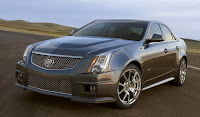Cadillac Aera Concept, 2010
The Cadillac Aera Concept won the 2010 Los Angeles Auto Show Design Challenge, tying with Smart and besting entries from seven other automakers including Mercedes-Benz, Honda, Nissan, Toyota and Maybach. GM Advanced Design has now won the honor more times than any other design team; this is its third victory since 2005.
The Cadillac Aera Concept is powered by compressed air via a highly efficient Pneumatic Drive System that has a 10,000-psi composite air storage tank with capacity for a 1,000-mile range. Flexible, pressurized air cells in the exterior skin, similar to material developed for the NASA Mars Rover airbags, enhance passive safety and interior comfort. The flexible polymer skin optimizes aerodynamics and functions as an ultra-lightweight alternative to conventional body panels and glass.
Cadillac Aera's body utilizes a 3D lattice, mono-formed frame that was designed to be similar to configurations found consistently in nature. The structure is formed from unique, alloy-utilizing, semi-solid freeform manufacturing, creating a naturally strong, extremely lightweight frame. All major body parts, including interior components, are essentially "grown" into a single part lattice structure.
The interior is crafted with an ultra-light recyclable polymer that allows for HVAC channels, fully adjustable seating, storage and comfort features all in one mono-form structure. Generous storage space accommodates luggage for two people.
The concept was conceived in GM's North Hollywood Advanced Design Studio by Frank Saucedo, director; Phil Tanioka, vehicle designer; Brent Wickham, concept strategist; Shawn Moghadam, layout designer and Timonen, the project manager. Earlier this week, GM commemorated 10 years of advanced design at the L.A. area studio.
The Design Challenge is part of the Design Los Angeles automobile designers' conference and has evolved into an integral element of the Los Angeles Auto Show. Design Los Angeles connects those working in the design industry with well-known automotive design industry leaders. Los Angeles is home to the world's largest concentration of manufacturer design studios, representing automakers from North America, Europe and Asia. It is also the home of Art Center College of Design, one of the world's foremost transportation design institutions where many of today's leading automotive designers began their careers.
The Cadillac Aera Concept is powered by compressed air via a highly efficient Pneumatic Drive System that has a 10,000-psi composite air storage tank with capacity for a 1,000-mile range. Flexible, pressurized air cells in the exterior skin, similar to material developed for the NASA Mars Rover airbags, enhance passive safety and interior comfort. The flexible polymer skin optimizes aerodynamics and functions as an ultra-lightweight alternative to conventional body panels and glass.
Cadillac Aera's body utilizes a 3D lattice, mono-formed frame that was designed to be similar to configurations found consistently in nature. The structure is formed from unique, alloy-utilizing, semi-solid freeform manufacturing, creating a naturally strong, extremely lightweight frame. All major body parts, including interior components, are essentially "grown" into a single part lattice structure.
The interior is crafted with an ultra-light recyclable polymer that allows for HVAC channels, fully adjustable seating, storage and comfort features all in one mono-form structure. Generous storage space accommodates luggage for two people.
The concept was conceived in GM's North Hollywood Advanced Design Studio by Frank Saucedo, director; Phil Tanioka, vehicle designer; Brent Wickham, concept strategist; Shawn Moghadam, layout designer and Timonen, the project manager. Earlier this week, GM commemorated 10 years of advanced design at the L.A. area studio.
The Design Challenge is part of the Design Los Angeles automobile designers' conference and has evolved into an integral element of the Los Angeles Auto Show. Design Los Angeles connects those working in the design industry with well-known automotive design industry leaders. Los Angeles is home to the world's largest concentration of manufacturer design studios, representing automakers from North America, Europe and Asia. It is also the home of Art Center College of Design, one of the world's foremost transportation design institutions where many of today's leading automotive designers began their careers.

































